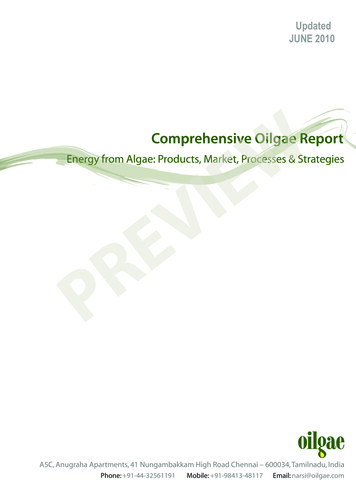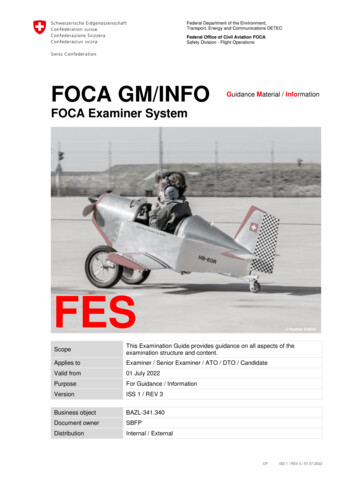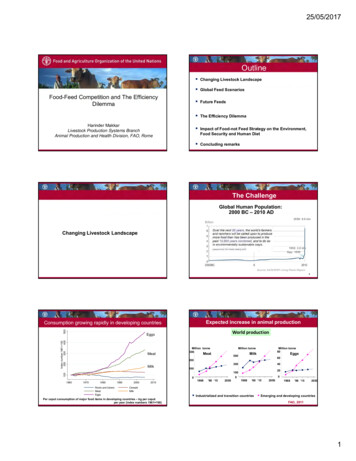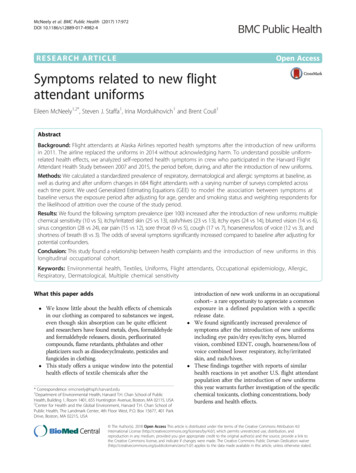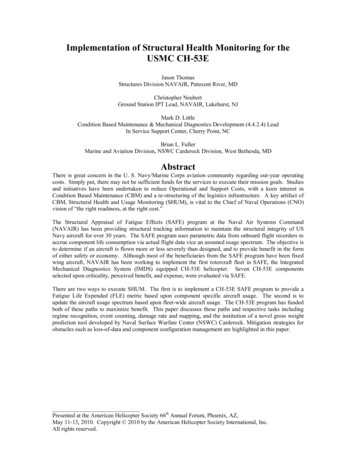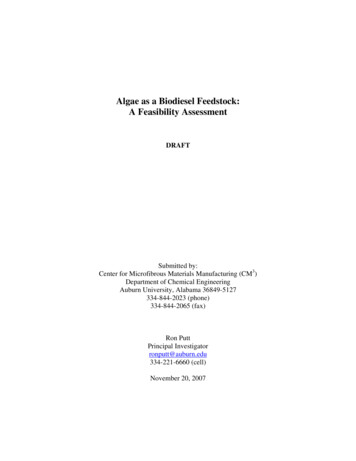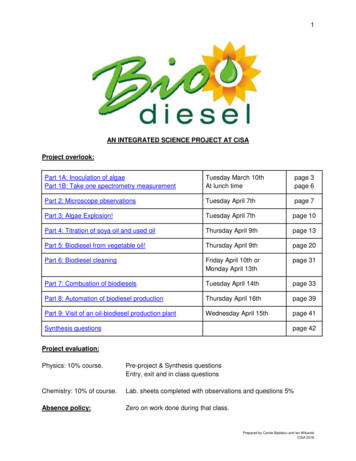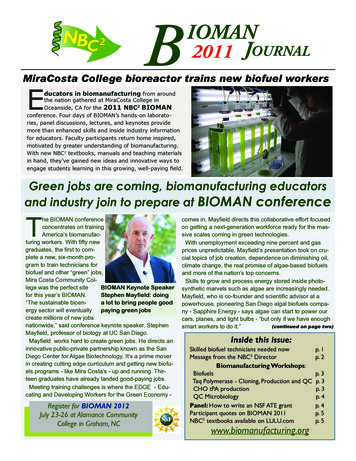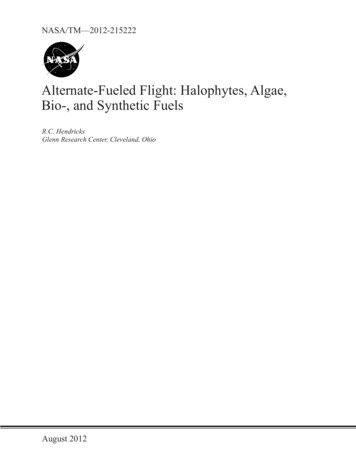
Transcription
NASA/TM—2012-215222Alternate-Fueled Flight: Halophytes, Algae,Bio-, and Synthetic FuelsR.C. HendricksGlenn Research Center, Cleveland, OhioAugust 2012
NASA STI Program . . . in ProfileSince its founding, NASA has been dedicated to theadvancement of aeronautics and space science. TheNASA Scientific and Technical Information (STI)program plays a key part in helping NASA maintainthis important role.The NASA STI Program operates under the auspicesof the Agency Chief Information Officer. It collects,organizes, provides for archiving, and disseminatesNASA’s STI. The NASA STI program provides accessto the NASA Aeronautics and Space Database andits public interface, the NASA Technical ReportsServer, thus providing one of the largest collectionsof aeronautical and space science STI in the world.Results are published in both non-NASA channelsand by NASA in the NASA STI Report Series, whichincludes the following report types: TECHNICAL PUBLICATION. Reports ofcompleted research or a major significant phaseof research that present the results of NASAprograms and include extensive data or theoreticalanalysis. Includes compilations of significantscientific and technical data and informationdeemed to be of continuing reference value.NASA counterpart of peer-reviewed formalprofessional papers but has less stringentlimitations on manuscript length and extent ofgraphic presentations.TECHNICAL MEMORANDUM. Scientificand technical findings that are preliminary orof specialized interest, e.g., quick releasereports, working papers, and bibliographies thatcontain minimal annotation. Does not containextensive analysis.CONTRACTOR REPORT. Scientific andtechnical findings by NASA-sponsoredcontractors and grantees. CONFERENCE PUBLICATION. Collectedpapers from scientific and technicalconferences, symposia, seminars, or othermeetings sponsored or cosponsored by NASA. SPECIAL PUBLICATION. Scientific,technical, or historical information fromNASA programs, projects, and missions, oftenconcerned with subjects having substantialpublic interest. TECHNICAL TRANSLATION. Englishlanguage translations of foreign scientific andtechnical material pertinent to NASA’s mission.Specialized services also include creating customthesauri, building customized databases, organizingand publishing research results.For more information about the NASA STIprogram, see the following: Access the NASA STI program home page athttp://www.sti.nasa.gov E-mail your question to help@sti.nasa.gov Fax your question to the NASA STIInformation Desk at 443–757–5803 Phone the NASA STI Information Desk at443–757–5802 Write to:STI Information DeskNASA Center for AeroSpace Information7115 Standard DriveHanover, MD 21076–1320
NASA/TM—2012-215222Alternate-Fueled Flight: Halophytes, Algae,Bio-, and Synthetic FuelsR.C. HendricksGlenn Research Center, Cleveland, OhioPrepared for theWorkshop on Alternate Fueling Sustainable Supply and Halophyte Summitsponsored by Atlantic Green FuelsTwinsburg, Ohio, October 18–19, 2007National Aeronautics andSpace AdministrationGlenn Research CenterCleveland, Ohio 44135August 2012
Trade names and trademarks are used in this report for identificationonly. Their usage does not constitute an official endorsement,either expressed or implied, by the National Aeronautics andSpace Administration.This work was sponsored by the Fundamental Aeronautics Programat the NASA Glenn Research Center.Level of Review: This material has been technically reviewed by technical management.Available fromNASA Center for Aerospace Information7115 Standard DriveHanover, MD 21076–1320National Technical Information Service5301 Shawnee RoadAlexandria, VA 22312Available electronically at http://www.sti.nasa.gov
Alternate-Fueled Flight: Halophytes, Algae,Bio-, and Synthetic FuelsR.C. HendricksNational Aeronautics and Space AdministrationGlenn Research CenterCleveland, Ohio 44135AbstractSynthetic and biomass fueling are now considered to be near-term aviation alternate fueling. Themajor impediment is a secure sustainable supply of these fuels at reasonable cost. However, biomassfueling raises major concerns related to uses of common food crops and grasses (some also called“weeds”) for processing into aviation fuels. These issues are addressed, and then halophytes and algae areshown to be better suited as sources of aerospace fuels and transportation fueling in general. Some of thehistory related to alternate fuels use is provided as a guideline for current and planned alternate fuelstesting (ground and flight) with emphasis on biofuel blends. It is also noted that lessons learned fromterrestrial fueling are applicable to space missions.IntroductionThese materials represent an update (to 2009) and additions to the Workshop on Alternate FuelingSustainable Supply and Halophyte Summit at Twinsburg, Ohio, October 17 to 18, 2007 (ref. 1).In the brief discussion herein, we will look at reasons why halophytes and algae are beinginvestigated as fuel, food, and energy sources.To produce biomass fuels, sources of carbon, hydrogen, oxygen, nutrients, and sunlight are required.Basically for fuels we need glucose, C6H12O6, or cellulose, (C6H10O5)n.In this respect (stoichometrically), glucose ties up six waters and six carbons for every unit of glucoseproduced. When the carbon input is from CO2,12H2O 6CO2 C6(H2O)6 6H2O 6O2Cellulose ties up five waters and six carbons in form of a polymer:2H2O 6CO2 C6(H2O)5 7H2O 6O2In round numbers, to make 2 kg of biomass one ties up about 1 kg of water and 3 kg of CO2 plusnutrients (fertilizer), which complicates matters. So to actually produce the biomass, in addition to waterand CO2, one needs nutrients and photons (400 to 700 nm)—all in the proper proportions.H2O CO2 NH3 Photons Biomass(CNxHyOz) O2This elementary notion of conversion points out that sustainable biomass sources require sunlight,suitable “soils,” nutrients, CO2, water, symbiosis, and a lot of care—all of which become major concerns.How do we address these major concerns? Do we pump water from freshwater aquifers, use waste andbrackish waters, use seawater, or what? Do we use open-air CO2 capture, exhaust stack capture, wellcapture, ponds, reactors, or what? Do we locate in hot dry, hot humid or cool, moist climates for growthor what? Do we pump water, CO2, or nutrients to the “fuel factory,” use conventional farming techniques,grow in vertical arrays, or what? Should we really process biomass into fuels at the expense of our foodsupply or what? Should we permit climate changing deforestation to produce biomass fuels or what?NASA/TM—2012-2152221
While these questions are both scientific and political, they also require a paradigm shift in our productionand use of energy, water, and food resources.From this very simple illustration of biomass needs, questions, and major concerns, we will show thatcommon food crops and grasses (some also called “weeds”) have already been processed into aviationfuels in limited quantities. We then show why halophytes and algae are better suited as sources ofaerospace fuels and transportation fueling in general. We will then provide some of the history related toalternate fuels use as a guideline to some current and planned alternate fuel testing, both ground andflight, with emphasis on blended biofuels.We will not discuss, to any extent, the coal-to-liquid (CTL) or gas-to-liquid (GTL) synthetic fuelingprocessing to S8 (synthetic JP8 or now being referred to as synthetic paraffinic kerosene (SPK) and usedinterchangeably herein) or JP900 techniques, as these have been addressed (e.g., refs. 2 to 6).Glycophyte Crop and Grass FuelsGlycophytes are sweet water (freshwater) plants, and they represent common sources of food.UOP-Honeywell, University of North Dakota (UND), General Electric (GE), and Inventurechem(ref. 7) all have processing technologies to convert common food-based crops and grasses to biojet. Threeof these (UOP, UND, and GE) were sponsored under DARPA proposal BAA06-43, for crop and weedconversion to JP8. These common crops include plant nuts, fruits, and seeds, for example, with palm oil,canola oil, and waste fats having potential for processing to S8 (synthetic JP8) (ref. 8). The same processcould be applied to a variety of bio-oil-based feedstocks, yet sustainability, transport logistics, and costsrequire consideration.It appears that all cited processors have provided fuels to Boeing and the Air Force ResearchLaboratory (AFRL) for testing, most under the designation of fuel 1, 2, 3, and so forth. Jet fuels willbenefit from commercialization of the Department of Defense (DOD) need for JP8 and S8.The major problems with glycophyte crop and grasses conversion to fuels are(1)(2)(3)(4)Lack of sustainable sources, as assessments and processes assume feedstock availabilityLack of realistic business (commercialization) model for total biomass productCompetition with demands for (i) arable land that produces food and (ii) freshwaterProcess is energy intensivePotentially sustainability and commercialization issues could be overcome, yet human energy, food,and water demands are inevitable sources of conflict with using crops for fueling.Halophytes, Algae, and Cellulosic FeedstocksIn view of the competitive nature of glycophyte fuel sources with the Triangle of Conflicts (energy,water, and food), we seek alternatives in plants that thrive in brackish and saltwater with the ability tosurvive in arid lands. These represent major concerns that are raised in the Introduction. A nice summaryis given by Whitfield (ref. 6).Of the Earth’s landmass, 43 percent is arid or semi-arid, and 97 percent of the Earth’s water isseawater. Halophytes are salt-tolerant plants (micro and macro) that can prosper in seawater or brackishwaters and are currently common feedstocks for fuel and food (fuel-food feedstocks) in depressedcountries. Two types, broadly classed as coastal and desert, can be found in marshes, coastal planes,inland lakes, and deserts. Major arid or semi-arid halophyte agriculture problems include pumping anddraining the required high volumes of irrigation water from sea or ocean sources. Also, not all arid orsemi-arid lands are suitable for crops. Benefits of halophyte agriculture include freeing up arable land andfreshwater resources, cleansing the environment, decontaminating soils, desalinating brackish waters, andcarbon sequestration. Sea and ocean halophyte agriculture problems include storms, transport, and diffuseharvesting. Benefits include available nutrients along with ample water and sunlight.NASA/TM—2012-2152222
Carefful attention too details and useu of saline agriculture fuuel feedstockss are requiredd to preventanthropoggenic disasters. In theory thhe potential foor fuel-food ffeedstock haloophyte produuction is high;based on testt plot data,, it could suppply 421.4 Quaad, or 94 perccent of the 2004 world eneergy consumpptionand sequeester carbon, withw major immpact on the TriangleTof Coonflicts (ref. 99).Whilee theory pointts the way, appplications annd developmennt of these pllants become the work of thheday. We investigate thee work on seaashore malloww, a halophytee grass, and ssome halophyyte work in Isrraelalong withh a note on otther sources forf algae oils and conversioons along witth potential haalophyte and algaeprojects. ManyMother saaltwater-tolerrant plant projjects are suppported throughh the Internattional Center forBiosaline Agriculture (ref.(10).Halophyte: Seashore MMallowhore mallow (Kosteletzkyaa virginica) (KKV) is amongg the many salltwater-toleraant plants thattSeashgrow in thhe wilds of coostal marshlannds or inland brackish lakees. Halophytee plants can reemediate soilss,capture caarbon, free upp freshwater, anda produce fuel-foodffeeddstocks, withh seed producttion similar too thatof soybeaans. With the riser of sea levvels due to glaacial melt impperiling seashhores, halophyytes and salt wwateralgae are beingblooked upon as majoor sources of fuel-food feeedstocks (Henndricks and Bushnell, refs. 1and 9).water irrigationn of plants is foreign to moost agriculturaal minds, yet Hodges (ref. 11) proposess thatSaltwa complette communityy life-cycle syystem can be developeddto grow plants, collect freshwwater, free coostallands for humanhoccuppation and at thet same timee provide all tthe attributes cited prior (DDr. Carl Hodgges,ref. 12).Schilll (ref. 13) reports on the seeashore mallow and the woork of Dr. Johhn Gallagher aat University ofDelaware, where in 2007 a 2.5 acre test plot prodduced 13 bu/aacre in a very dry season wwhere conventtionalsoybeans averaged only 24 bu/acre (normal is 400 to 50 bu/acree). The near sspherical seedds (fig. 1), simmilarNASA/TMM—2012-21522223
in size to wheat seeds, are planted and harvested using conventional farm machinery with adjustments forplanter plates and combine operating speeds. The oil content of seashore mallow is also similar to that ofsoybeans (about 18 percent) with fatty acid composition more like cottonseed.A very concise summary of the Gallagher and Seliskar halophyte work, background, halophytesmerits, and recent successful harvest is seen on their one-page summary (fig. 5 in the appendix) (ref. 14)and a more complete discussion of the seashore mallow (KV) work is found in (ref. 15). See theappendix.In correspondence with Prof. Gallagher regarding seashore mallow, more agricultural details evolved.Considering about 13 percent scatter-loss before harvest, replicate plot yields were 14 bu/acre. Thisreasonably good yield was without irrigation on Delaware farmland at a time when the county agentestimate on soybeans without irrigation “at least a 75 percent reduction in normal yield” because of 2007summer drought. The previous year (2006), soybeans yielded about 40 bu/acre. Prof. Gallagher did notthink KV would have benefited as much as beans with freshwater irrigation because of its droughttolerance. The KV would have benefited from salt-water irrigation for two reasons: (1) weed control and(2) a boost in growth from some salt. Very little fertilizer was used on the replicate plot in the spring so asto not encourage the weeds since farming was no-till and they did not have salt water to control theweeds. The older plants grow quickly in the spring, and the plant-canopy closes quickly. Except for themare’s tail, which is roundup resistant, weeds really did not cause a lot of problems.An objective of growing seashore mallow is low-maintenance, twice-in-the-field equipment (plantand harvest) biomass production. Higher productivity can result from irrigation, monitoring, insecticides,and nutrient care.In the first year of Prof. Gallagher’s field trials, a single KV shoot emerges that fills out into multipleshoots the following year and eventually the rows become indistinguishable (ref. 13).The first time KV was planted, the soil was tilled before planting and eventually weeds took control.The next time, conventional no-till agriculture was practiced: weeds were just sprayed, and KV wasplanted in the spring. The second year for the no-till crop (Spring 2007), the KV was sprayed and a littlefertilizer spun on just before the shoots broke the surface in late April. The next time Prof. Gallagher tookmachinery to the field, it was to combine (harvest). The third-year plant shoots look very promising andare becoming an established crop.Prof. Gallagher feels that KV agriculture would thrive on the coastal plains and that the potential forrapid increase in yield from just simple (KV) selection is very good. Future work includes testing withinand between the established lines and collecting more samples from the range of genotypes in the wild.When comparing soybeans grown in the 1950s to the modern beans, keep in mind that we do not want togo from today’s KV to a plant that needs the water, fertilizer, and insecticide pampering the sweet cornfarms around Delaware require.Halophyte: Salicornia BigeloviiSalicornia bigelovii, a leafless annual salt-marsh plant with green jointed and succulent stems, isindigenous to the Arabian Sea coasts of Pakistan and India on the margin of salt lakes and Celon (SriLanka) (ref. 16), the U.S. Southwest, and other parts of the world. Similar varieties have been developedand are grown by Hodges (ref. 11) and Yensen (refs. 17 and 18). See also Hendricks and Bushnell (ref. 1)and reference 19.Scalicornia bigelovii (author’s hybrid variety sos-10) seed collected from field trials in five areas onthe Arabian Sea coast were processed by hexane extraction, producing 27.2 to 32.0 percent oil. The oilacid content is given in table I; it has a refractive index of 1.4680 and a density 0.9054 g/cm3. It can beseen many parameters were found to be quite compatible with those of safflower oil, which had slightlyhigher oil (4 percent), fiber (2 percent), and ash (0.5 percent), with 2 percent lower protein (ref. 16). Thesafflower seeds were from four different harvests (MSDS oil density, 0.921 g/cm3).NASA/TM—2012-2152224
TABLE I.—PERCENTAGE ACID CONTENT OF SEED OILS[After ref. finedacidsbigeloviiC16:0 palmitic7.52 0.246.70 0.251111.76(7.00–8.50)(6.03–7.81)C18:0 stearic1.45 0.072.50 0.104.14.64(1.24–1.69)(2.05–3.00)C18:1 oleic13.42 0.5612.30 0.702224.98(12.33–16.83)(9.50–15.70)C18:2 linoleic ω675.50 2.0478.00 3.505455.41(74.66–79.49) (73.60–80.04)1.98 0.097.53.8C18:3 linolenic ω3(1.50–2.30)areference 20, tion.html,soybean commercial products.breference 21, http://www.scielo.br/scielo.php?pid S010390162005000300014&script sci arttext, soybean refined oil.Both salicornia bigelovii and safflower seed have greater oil content than cotton (15 to 24 percent)and soybeans (17 to 21 percent). Salicornia bigelovii saponin detoxification can be accomplished bypre-extraction soaking the seed in 1% NaOH permitting use of protein residual as animal feed.Sustainable Halophyte Grasses (Distichlis Spicata)Many arable land areas are at risk or affected by salinity, due to shallow or rising water tables,underground pumping, and climate changes. For example, in the year 2000 Australia had an estimated5.7 million saline-affected hectares, with potential to reach 17 million hectares (170 000 km2) by 2050(ref. 22). According to Sargeant, Tang, and Sale (ref. 23), these sites are generally regarded as degradedfrom a chemical and physical perspective, with high concentrations of dissolved salts within the rootzone, and are commonly waterlogged. There are very few ways that landholders can use these degradedareas for commercial use. In most cases, they are abandoned and lost from the farming system.Distichlis spicata (fig. 2) is the only C4 species most suited to the high temperatures and highradiation regimes during the warm summer months of southern Australia (ref. 23). This species not onlyhas the ability to grow and spread in saline waterlogged soils, but it also produces valuable green feed inmoist saline discharge soils during the summer period. Such forage has real value for a mixed farmingsystem.Sargeant, Tang, and Sale (ref. 23) have found that Distichlis spicata var. yensen-4a is sustainable insaline and seasonally waterlogged sites and becomes a productive option for landholders as a way ofutilizing an otherwise abandoned unproductive land. They found significant improvements in soilconditions for Distichlis spicata (var. yensen-4a (NyPa Forage) is a halophytic pasture grass) growing insaline discharge. Fields planted 2 to 8 years were investigated at three different sites. The fields have beenunder landowner observation, where the largest improvements are found in the 8-year sward within soildepths of 0.1 m. Soil measurements included saturated hydraulic conductivity, water-stable aggregates,root length and dry weight, electrical conductivity, pH, and soil nitrogen and carbon. Results showed a12-fold increase in saturated hydraulic conductivity, with increases in both nitrogen and carbon withoutnoticeable increases in salt accumulations in the rooting zones. The magnitudes varied between soil type,age topography of field. The baselines were adjacent no-grass zones.These improvements are consistent with the results of research conducted in Pakistan, where the salttolerant Kallar grass (Leptochloa fusca) was shown to improve the physical properties of saline-sodicsoils (refs. 25 and 26).Seashore saltgrass is also native to the United States.NASA/TM—2012-2152225
Furthher Halophyytes and Alggae ResearcchA varriety of halophhyte and algaae work is beinng carried ouut in Israel witth a recent bioomass andbiofuels meetingmheld ini Haifa, Israeel. The meetinng was entitleed “The Enerrgy Forum—EEnergy from BBioFuels (16.10.2007)” heeld at the Sammuel Neaman Institute, Haiifa. There werre no proceeddings, but topics ofdiscussionn are providedd (ref. 27).In commmunicationss, Prof. Amraam Eshel (ref. 28) (and Proof. Yoav Weissel), Tel-Avivv UniversityDepartmeent of Plant Scciences, writees that they arre studying thhe potential off desert halopphytes as sourrcesof biofuell or biodiesel. They startedd testing certain desert plannts mentionedd in the literatture as potentiialbiodiesel plants. The basic idea is too develop metthods for bioffuel or biodieesel productioon that will nootcompete withw agricultuural resources devoted to foood productioon. Thereforee, they search for deserthalophytees that could beb grown on marginalmsoilss using margiinal quality wwaters and servve as sources ofbiofuel orr biodiesel. Inn the deserts ofo the world thhere are largee areas that aree not currentlly undercultivationn, and saline or reclaimed water would enable arid laand productivvity. Even thee so-called seccondgenerationn plants—Casstor beans andd Jathropha——will not groww well under such conditioons.They have also achhieved over 25 t/ha/y dry trree biomass pproduction unnder desert coonditions andreclaimedd water irrigattion. Until effficient methodds for cellulosse degradation are availablle, these could beused for earningeCleann Developmennt Mechanismm (CDM) creddits by afforesstation projeccts in third-woorldcountries. It may turn outo that even though algae production iss much greateer than that off halophytes, theinvestmennt costs couldd mean that haalophytes wouuld be better? The algae isssues are veryy nicely coverred byProf. Ben-Amotz (ref. 29).AlgaeACommmercial Foodd, Medicine,, and Fuels--Potentialnto know thet process annd methods too reduce costts as cited perr the model innAlgal processors needmbiotic and Issrael Electric. AlgaTech, Israelreference 29. Inventureechem.com haas an agreemeent with Seama Earthrise Nutritionals LLC,LCalipatrria Californiaa USA, (ref. 331) are commercial food(ref. 30) andsuppliers with a large industryiin Indonesia suppllying food suupplements to Japan.A nonnfood algal prroduction anaalysis presenteed at the San Francisco Allgal Summit, BBen-Amotz(ref. 29) showss50:1 coost reduction usinguCO2 staackgas. Ben-AAmotz cites FFGD Power Station, Ashkeelon,Israel (431 mt CO2 /hr,, 10 344 mt COC 2 /day) withh average midd-large stationn at 4000 mt CCO2/hr. In roundNASA/TMM—2012-21522226
numbers, 2 kg biomass requires 1 kg water and 3kg CO2 plus maybe up to 1 kg nutrient fertilizers(questionable). For complete capture and stoichiometric conversion, a natural-gas-fired 4000 mt-CO2/hrpowerplant has the potential to produce 2660 mt biomass/hr while consuming 1330 mt water/hr(16 000 mt biomass, 7980 mt water, and about 8000 mt nutrients, assuming 6 hr/day production).In a Vertigro system, a flat-surface greenhouse is essentially turned into a series of vertical surfaces.Plants can be grown in containers attached to vertical transparent sheets suspended from an overheadconveyor system. In the algal growth system, the suspended sheets become vertical multipass horizontaltubular plastic-encased bioreactors. The fluid containing algae is pumped up, and it cascades downthrough the series of horizontal tubes with a high degree of mixing at the end turnaround and entry to thenext horizontal passage. The arrays are spaced to allow maximum light penetration and flow rates, CO2,and nutrients adjusted to provide optimum algal growth. The algae are reported to consume up to90 percent their weight CO2 with 50 percent dried weight as lipid or oil content. The system conservesboth land and water, as little or no water is lost to evaporation and is somewhat immune to foreign algalstrains. Estimates are that a fully operational plant may produce to 4000 bbl bio-oil/acre/year, three ordersof magnitude more than soybeans (refs. 32 and 33). A similar scaleable modular photobioreactor systemconcept is discussed by Kodner (ref. 34).The 2007 Algae Biomass Summit in San Francisco was like a road map of potential ways, along withpartnerships, to make cellulosic and algal oils for processing into JP8 (ref. 35).Other Research and DevelopmentsNorth Carolina State University has developed a process to turn virtually any lipidic compound(e.g., algae) into fuels for aviation (includes oil from algae) (ref. 36). The process is licensed toDiversified Energy Corp. (ref. 37) of Gilbert Arizona. Principles in the North Carolina group includeProfs. William Roberts, Henry Lamb, Larry Stikeleather, and Tim Turner of Turner Engineering inCarrboro, N.C.Aquaflow Bionomic Corporation (New Zealand) (ref. 38) harvests algae directly from settling pondswith significant oil yields. Similar efforts are found at Solix Biofuels and Colorado State University(ref. 39; see also ref. 40) for commercializing algae to biodiesel. Solix photobioreactors and ponds arebased on the National Renewable Energy Laboratory (NREL) Aquatic Specie Program. Both Aquaflowand Solix should be massively scalable.GreenFuel Technologies Corporation (ref. 41) and Arizona Public Service Company (APS) (ref. 42)were able to grow algae successfully at APS’s Redhawk natural gas power plant. GreenFuel Technologiesalso has an agreement with Institut fur Getreideverarbeitung Potsdam (ref. 43) Germany for algaeproduction.Trident Exploration Corp. (ref. 44) and Menova Energy Inc. (ref. 45), are to develop aphotobioreactor. Menova systems are applicable to photovoltaic, solar thermal, or light piping.The National Science Foundation (NSF) has published a roadmap for the production of hydrocarbonbiofuels, liquid transportation fuels derived from lignocellulosic biomass that are close analogs to theirpetroleum-derived hydrocarbon counterparts (refs. 46 and 47).The Bali Indonesia Red Cross volunteers are planting tens of thousands of mangroves to inhibit costalsoil erosion (ref. 48). It would be good if the project also envisioned aqua- and agriculture similar to thatof Hodges (ref. 11) to enhance regional development, conserve freshwaters, and provide energy and foodto fracture the Triangle of Conflicts (energy, food, and water).Potential for Dead Sea and Death Valley Community ProjectsSeveral prospective algae-oil consortiums are investigating the nutrient rich Sultan Sea in Californiafor algae growth, there other areas that could benefit from seawater agriculture and aquaculture. Basicallymost areas near oceans or seas could benefit from the work of Hodges (ref. 11).NASA/TM—2012-2152227
Cellulosic andaAlgal Fue l GoalsIn thee conceptual reclamationrof the Dead Seea by sea-watter pumping (rref. 49), the cconcept of Hoodges(ref. 11) couldcreadily beb adapted too supplementiing the Sea wiith even moree make up waater, freeing uupfreshwateers, and buildiing seashore communities.cRather than hharvesting mminerals these communitiescould enaable harvests ofo food and fuuel feedstockss from halophhytes and algaae resulting inn sustainableindependeence of energy, water, and food when coombined withh solar photovvoltaic (PV) ssystems(e.g., ref. 50).A simmilar project withw sustainabble growth of halophytes annd algae coulld be envisionned for DeathhValley 2882 ft (86 m) beelow sea leveel in southwesstern United SStates. The neecessary wateer could besupplied byb pumping seawater throuugh a suitablee land route orr combined wwith gravity feeed throughtunneling. Both the Deead Sea and DeathDValley couldcuse simmilar pumpingg and gravity ffeed systems. Inboth casess one could leearn how aridd land plants survive,sfrom plants uniquee to the harshhest of desertss.(As a notee, Los Angless freshwater comescfrom thhree aqueductts, one of whiich is the Sierrra Nevada-LoosAngeles Aqueduct).AAlthoough there aree many commmercial and pootential sourcees for halophyytes and algaee, the cost anddsustainablle productivitty are major factors.faFor algae the produuction can be very high, att a current cosst ofabout 10 that of conventional biommass oils. Thiss issue is beinng aggressiveely addressed by many algaaeproponentts and DARPA proposal BAA08–07B(fiig. 3) (ref. 51)), which addrresses commeercialization oofboth algaee and cellulossic biomass coonversion to JP8.JThe esseential requiremments of the BBAA directeddtoward suustainable commmercial prodduction of JP88-biojet are seet forth as goaals, not absolutes.Cellulosic ConversionCto FuelsDARPPA BAA08–007 also seeks biomass fuells from algal aand cellulosicc material feeedstocks (ref. 51).Evers Tecch, Indiana-Puurdue Lugar EnergyECenteer (Mike Hudsson, Andrew Hsu, Richardd Wagnerprincipalss) (refs. 52 and 53), and Veentech Engineeering (ref. 544) are workinng on a processs for converttingwaste matterials to bioffuels as originnally cited by Evers Tech inn Atlantic Grreenfuels (reff. 1). The folloowinglist providdes examples of wastes witth potential coonversion to energy-fuel rresources:(1) LocalLlivestock wastelandfill wasteesewage sludgge wastealgal waste (ponds ? summmer pond allgae)(2) RegionalRsolid wastes (municipal)forest wastesstire wastesothers classiffied above unnder Local thaat can be shippped inexpenssivelyNASA/TMM—2012-21522228
A recent alliance between ICM In
Alternate-Fueled Flight: Halophytes, Algae, Bio-, and Synthetic Fuels NASA/TM—2012-215222 August 2012 National Aeronautics and Space Administration Glenn Research Center Cleveland, Ohio 44135 Prepared for the Workshop on Alternate Fueling Sustainable Supply and Halophyte Summit sponsored by Atlantic Green Fuels Twinsburg, Ohio, October 18 .
